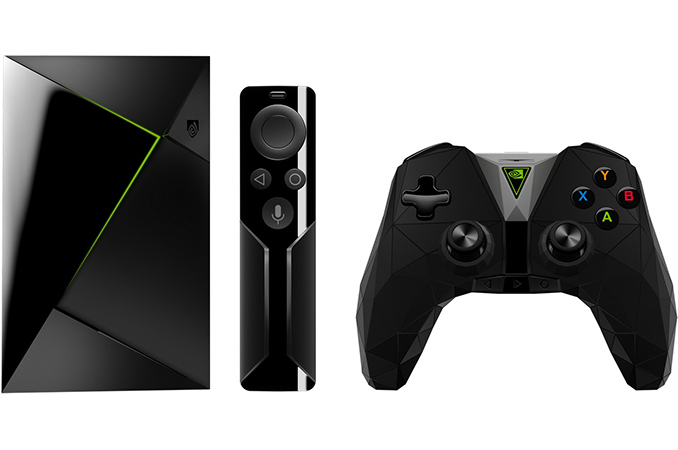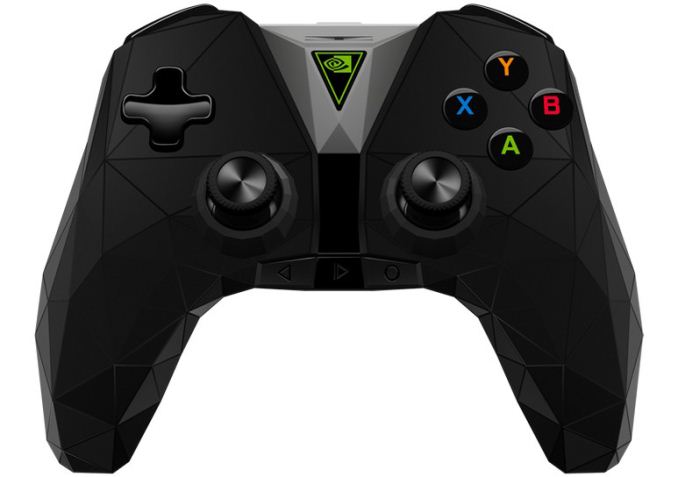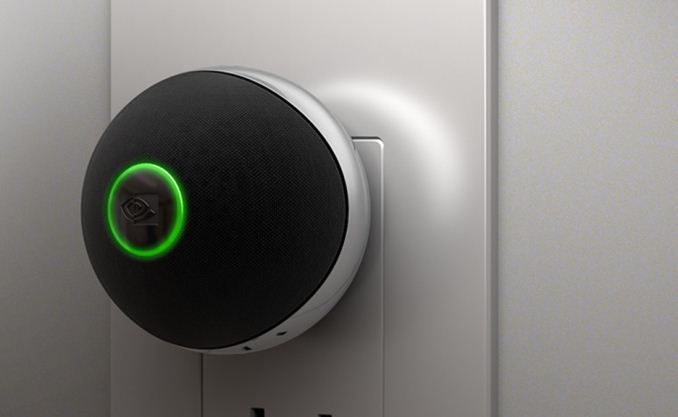NVIDIA Launches SHIELD TV: Smart Home Functionality, More 4K HDR Streaming Services
by Anton Shilov on January 10, 2017 3:00 PM EST- Posted in
- Consoles
- Shield
- NVIDIA
- Android TV
- HDR

NVIDIA at CES launched its updated SHIELD set-top-box (STB), with an expanded feature-set as well as smaller and lighter form-factor. The upcoming NVIDIA SHIELD TV is based on the same Tegra X1 SoC as the previous-generation model launched in 2015, and like the mid-generation refreshes of gaming consoles that NVIDIA is clearly aiming to mimic, the launch of this slimmer console with updated software is meant to offer the hardware in a new form factor while calling attention to the major software updates being delivered to the platform this year. Among new features for the platform set to premiere in the near future is support for Google Assistant, compatibility with the SmartThings infrastructure and NVIDIA’s upcoming Spot wireless microphone.
NVIDIA launched the SHIELD Android TV back in the spring of 2015 as a quirky combination of lightweight Android gaming console and Android TV set-top-box, and the device quickly earned recognition as the most powerful and capable Android TV device on the market. Thanks to the versatility of the Tegra X1 SoC in general and its Maxwell display controller in particular, NVIDIA launched with a box capable of displaying 4Kp60 content, and managed to further improve feature-set of its STB over the last two years. In particular, NVIDIA added HDR display and streaming support, and was among the first devices to be certified for 4Kp60 streaming from Netflix and other over-the-top streaming services. While the original SHIELD Android TV still has a lot of potential, some of the things are being introduced with a new model, which is what SHIELD TV is all about.
From a hardware specifications point of view, the new SHIELD TV is essentially a cut-down version of the original 2015 model. The new device contains the same Tegra X1 SoC, similar RAM/storage configuration, and much the same I/O, etc. What NVIDIA has done away with is the 2.5" HDD bay (used in the Pro model), along with the microSD card slot, a micro-USB 2.0 port and an IR receiver. Instead the device's expandability and connectivity is delivered through the use of two USB 3.0 ports, along with Gigabit Ethernet and 2x2 802.11ac WiFi. As a result, the new SHIELD TV is considerably smaller and lighter than the original SHIELD Android TV thanks to the space savings (especially removing the HDD bay).
Update 1/11: The new SHIELD TV does not have an IR receiver.
| NVIDIA SHIELD STB Family | ||||
| SHIELD TV (2017) |
SHIELD TV Pro (2017) |
SHIELD Android TV (2015) |
||
| SoC | Tegra X1 (4 × Cortex A57 + 4 × Cortex A53, Maxwell 2 SMM GPU) | |||
| RAM | 3 GB LPDDR4-3200 | |||
| Storage | 16 GB NAND USB |
16 GB NAND 500 GB HDD microSD USB |
16 GB NAND 500 GB HDD (Pro only) microSD USB |
|
| Display Connectivity | HDMI 2.0b with HDCP 2.2 (4Kp60, HDR) | |||
| Dimensions | Height | 98 mm 3.858 inch |
130 mm 5.1 inch |
|
| Width | 159 mm 6.26 inch |
210 mm 8.3 inch |
||
| Depth | 26 mm 1.02 inch |
25 mm 1 inch |
||
| Weight | 250 grams | 654 grams | ||
| Power Adapter | 40 W | |||
| I/O | Wireless | 2x2 802.11a/b/g/n/ac Bluetooth 4.1/BLE |
||
| USB | 2 × USB 3.0 | 2 × USB 3.0 1 × micro-USB 2.0 |
||
| IR | - | IR Receiver | ||
| Ethernet | Gigabit Ethernet | |||
| Launch Product Bundle | Shield Controller Shield Remote |
Shield Controller | ||
| Launch Price | $199.99 | $299.99 | Basic: $199.99 Pro: $299.99 |
|
Another notable difference between the 2017 SHIELD TV and the 2015 SHIELD Android TV packages is the new gamepad controller, which loses some weight, ditches touchpad, but gains a microphone for the Google Assistant. The latter allows finding content, control playback and locating other information using voice commands. Technically, the original SHIELD Android TV also has a microphone on the remote, but it needs to manual activation, whereas the one on the new controller is “always on.” In fact, the new SHIELD controller can be bought separately to add hands-free commands to NVIDIA's SHIELD Android TV.
Up next is smart home functionality. Though this isn't making the initial Android 7.0 software release for the device, the SHIELD TV family will be receiving Google Assistant functionality later this year. This expands on the STB's original voice control functionality, particularly with always-on functionality. The old and new SHIELD TV STBs will also be able to act like the SmartThings Hub ($99 when sold separately), and when combined with an appropriate radio dongle, can communicate with compatible devices (such as Nest) using Zigbee and Z-Wave communication protocols.
Meanwhile, later this year NVIDIA plans to release its Spot device. The $50 Spot is a wireless microphone and a speaker that can be plugged in any power outlet within a home, relaying voice commands to SHIELD TV. The Spot is meant to further improve the usefulness of the SHIELD TV as a smart home hub by expanding the range over which it can hear commands for Google Assistant and compatible SmartThings devices.
Finally, NVIDIA announced that the SHIELD TV software update launching alongside the new hardware will also add support for 4K HDR content from both Amazon Video and Google Play Movies (will be available in the next few months), further expanding the selection of 4Kp60 and 4K HDR content on the platform. Speaking of HDR, NVIDIA's GameStream HDR functionality, first introduced in beta form last May, will also finally be moved to release status in the software update.
The new SHIELD TV STBs will come with NVIDIA's remote and the new gamepad by default. NVIDIA will ship the new SHIELD TV STB on January 16 and the systems are already available for pre-order at $199.99. The SHIELD TV Pro model with 500 GB HDD is priced at $299.99 and will ship on January 30.
Related Reading:
- The NVIDIA SHIELD Android TV Review: A Premium 4K Set Top Box
- NVIDIA Announces SHIELD Console: Tegra X1 Android TV Box Shipping In May
- NVIDIA SHIELD Android TV Console Adds Support for Vudu, HDR and 4Kp60 Content
- NVIDIA's GeForce NOW - GRID Cloud Gaming Service Goes the Subscription Way
- NVIDIA SHIELD Android TV OTA Update Improves HTPC Credentials
Source: NVIDIA

















19 Comments
View All Comments
Morawka - Tuesday, January 10, 2017 - link
Ask Nvidia if the 16GB model can be upgraded by the user by adding a internal 2.5" HDD or SSD.Last years model had the sata connector hookups on the PCB, but no connectors, making it impossible to add one.. I'm assuming you can always do USB, but i'd like to be able to add internal and not pay for a $100 upgrade that only adds a $35 hard drive.
savagemike - Tuesday, January 10, 2017 - link
Since the article explicitly mentions much of the physical down-size comes from removing the internal 2.5" bay I'm gonna go ahead and guess that they didn't also add the feature for the end user to install a 2.5" drive.Ichijoe - Tuesday, January 10, 2017 - link
Unless you had (or have?), mad soldering skilz you had about Zero chance of installing a HDD into the old 16Gb version. If anything I'm more p**sed that they removed the Touchpad from the new Gamepad. That to me speaks volumes about them ever bringing it back.Flunk - Tuesday, January 10, 2017 - link
Sure it can, you just need to put it in a USB enclosure and plug it into a USB port ;).SpartanJet - Tuesday, January 10, 2017 - link
No Dolby Vision and ADroid OS that features Gogle spyware? No sale. HDR10 is garbage compared to Dolby Vision anyway will wait for the LG Blu-Ray that will have streaming apps and Dolby Vision.Flunk - Tuesday, January 10, 2017 - link
Android doesn't support Dolby Vision so it's hard to support something the underlying OS doesn't support.nathanddrews - Tuesday, January 10, 2017 - link
All the more reason to avoid it.BillBear - Tuesday, January 10, 2017 - link
Did they not update the Tegra X1 at all? I was hoping for at least a die shrink.beginner99 - Wednesday, January 11, 2017 - link
Yeah i don't see why I should pay $200 for this when I can get a PS4/xbox for not much more.BenSkywalker - Wednesday, January 11, 2017 - link
Depending on your uses, for a streaming focused device the XBone is *terrible*, utter garbage. I picked up an S for a hopefully someday useful 4K BluRay player and the UI is clunky, cluttered, absurdly sluggish and most importantly the sound..... it's utter trash. Straight up, the lowest price point Chromecast curb stomps the XBoneS for sound quality, MS should be ashamed shipping a console with such putrid options for audio output in 2006(yeah, my point). Supposedly a fix is incoming in a firmware update, maybe, someday; until that point- the Shield outright annihilates the XBone as a streaming device.Now, the PS4 comparison is a bit better as at least Sony handles trivial functionality OK, and it integrates with modern devices significantly better than the XBone. That said, no streaming 4K HDR content with the PS4- again, Shield wins that battle easily.
If you are looking at Shield as a console replacement it is a tough sell at its price point, but, when you look at it as unquestionably the best consumer streaming device, it makes a lot more sense. On that front, it easily bests the PS4 and the Bone is still trying to match the PS3.